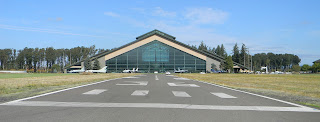On Monday, October 4, 2021 I visited the Evergreen Aviation & Space Museum over in McMinnville, Oregon. Its centerpiece is the one and only wooden Hughes Flying Boat, popularly known as the Spruce Goose. That eight-engine monster has a wingspan of 320 feet, a length of 219 feet, and a height of 79 feet. The nose faces the end of the museum shown above.
In a blog post on July 16, 2021titled Heritage Interpretation – telling historical stories to people, I quoted Freeman Tilden’s definition for interpretation, which is:
“An educational activity which aims to reveal meaning and relationships through the use of original objects, by first-hand experience, and by illustrative media, rather than simply to communicate factual information.”
Telling those historical stories in a museum involves letting people see the objects and explanatory placards (which should not have more detail than can be read in three minutes). They also can ask guides for even more details.
For example, a Consolidated PBY Catalina flying boat and its placard are shown above.
Another example is the 2,000 hp. Pratt & Whitney R-2800 Double Wasp radial engine. The placard provides context reminding us it had powered two famous WWII fighter planes, the Vought F4U Corsair and the Republic P47 Thunderbolt.
Another aircraft on display is a Piper L-4H Grasshopper (the military version of the Piper J-3 Cub). To further add interest, it is displayed along with an anti-tank bazooka rocket launching tube. The placard mentions Major Charles Carpenter, who was known as ‘Bazooka Charlie’ for his tank busting feats. His WWII exploits were described briefly on page 84 of the February 1945 issue of Popular Science magazine:
“PIPER CUB TANK BUSTER
Maj. Charlie Carpenter of the Armored Command got tired of seeing enemy tanks scurrying around below while he spotted artillery hits from his ‘grasshopper’ plane. So, with the assistance of the Ninth Air force Service Command and an associate in Ordnance, he equipped the Cub with bazookas, and went to work on the Germans. Under each wing he mounted a battery of three of the weapons, loaded and ready for firing by means of a cord pulled by the pilot. The prey was sized up from high altitude, and, since the enemy believed that the pilot was concerned only with artillery spotting, they did not notice the bazookas inconspicuously located under his wings. When he had picked his target, he spiraled down and swooped in just above the treetops for the kill.
The first day Carpenter knocked out one Tiger tank with each battery, and the latest available report shows his total to be 14. The photograph at the left is a muzzle-end view showing how three of the rocket hurlers are mounted on the struts of a Piper Cub. All three bazookas on one side are fired by a jerk on a lanyard, shaking the little ship like a fever chill.”
In the April 2020 issue of Air & Space Smithsonian there is another article by Jim Busha titled Bazooka Charlie and the Grasshopper: A tale of World War II.
For variety some of the aircraft are displayed hanging from wires rather than just sitting on their landing gear. As shown above, an aerobatic Russian YAK-50 is almost sideways, and a Pitts Special aerobatic biplane is upside down.
Some high-speed aircraft also are displayed in the Space Museum building. A North American X-15 rocket plane is displayed with its nose pointed skyward. The placard says:
“TO THE EDGE OF SPACE
In 1963, the X-15 took pilot Joe Walker to the edge of space twice! (An altitude greater than 100 km or 328,000 feet – approximately 62 miles – is considered space. Walker flew to 354,200 feet, more than 67 miles high). Walker was formally designated an astronaut for his achievement, preceding Gus Grissom by more than a year and a half as the first man to enter space twice. [X-a5 pilot Neil Armstrong, later becoming the first man to walk on the moon, and X-15 pilot Joe Engle went on to fly the space shuttle.] The X-15 flew 199 flights. The last was in October 1968. This is an engineering model of the X-15. IT was used for wind tunnel testing.”
There also is a Lockheed SR-71 Blackbird (shown with the outboard end of its left wing raised to reveal the engine). To its left is the accompanying D-21 drone it sometimes would carry.












No comments:
Post a Comment